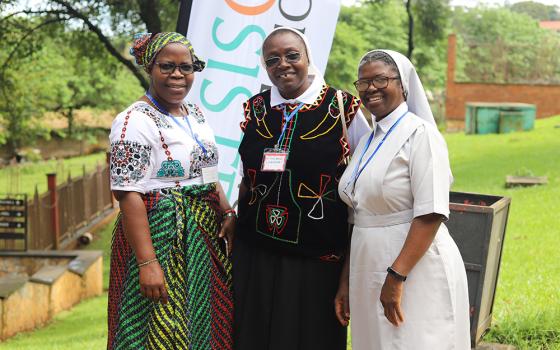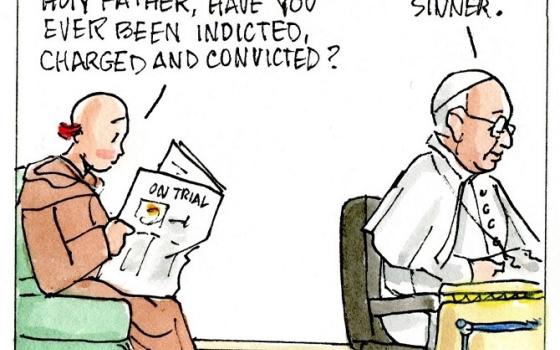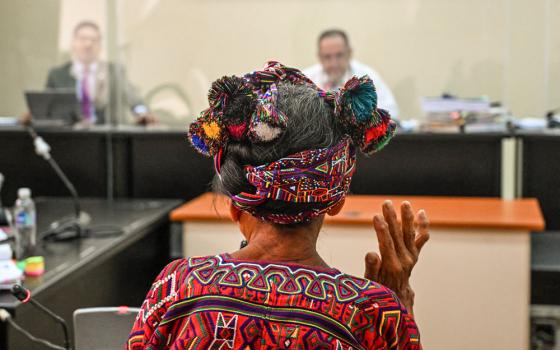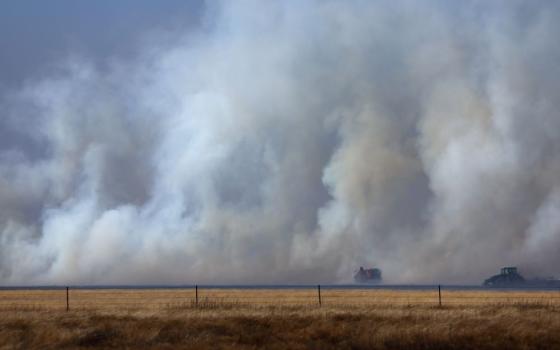After a lengthy and, at times, contentious debate over
recent years about a new English translation of the Order of Mass, which
relies more heavily on a sacred vocabulary closer to the Latin originals,
some observers were surprised by the relatively anti-climatic nature of
the vote of the American bishops last week in Los Angeles. Following a
fairly brief discussion, the bishops approved the translation by an
overwhelming vote of 173 to 29.
Several factors no doubt help explain the result, including a recent
letter from Cardinal Francis Arinze of the Congregation for Divine Worship
to Bishop William Skylstad, president of the American conference, which
made adoption of the text seem inevitable, and the general fatigue many
bishops feel with the "liturgy wars" which have rocked English-speaking
Catholicism since the mid-1990s.
One key element, however, was the support of Bishop Donald Trautman of
Erie, Pa., chair of the Bishops' Committee on Liturgy, widely seen as the
leading critic of the translation principles underlying the new text. In
the end, however, Trautman supported the translation in amended form. (The
American bishops approved several changes, such as retaining the phrase
"one in being" in the Creed rather than the more technical term
"consubstantial.")
This week, I spoke to Trautman about the result.
t
* * *
NCR: Many observers were struck by your position in Los
Angeles.
Bishop Trautman: I tried to steer a middle course. I
didn't want any consternation, and in the end we had a peaceful resolution
to these important liturgical matters. I wanted to take a balanced
approach. It's important to remember that this is an amended text. What we
have to do is to highlight the 'full, conscious and active participation'
of the faithful in the liturgy, and the texts we received were not always
good at this. The amended text brings us closer to that hope of the
council fathers. The texts should be easily understood, with a new
theological precision. I would have liked to see more amendments, but I
think we did well.
What needs to happen for successful implementation of the new
Mass?
What's required in the first place is a great motivation for
priests to take on a major catechetical effort. I would say that we're at
least two years away from [the translation] becoming reality, but we have
to gear up for that.
I'm
not in favor of any catechetical effort, however, until the whole Roman
Missal is ready. Only then will be we able to see the big picture. Then we
can talk about the catechetical effort. There's still a lot of material to
be prepared, such as the collects, prefaces, and other texts. We've sent a
strong message to ICEL [the International Commission on English in the
Liturgy, responsible for the translations] that the collects in their
present form are not worthy. They're too long, they use a sometimes
incomprehensible vocabulary, and they follow the Latin word order too
closely. There's a lot of work to be done.
What we don't want to do is to repeat the mistakes of the immediate
post-Vatican II period, when we came out with the Mass in segments with an
overall approach.
What's most important is the motivation to implement this translation.
We have to convince priests and lay people that this is a superior text,
giving them a deeper spirituality. I don't think we'll convince them that
'consubstantial,' for example, is better than 'one in being,' which has
been used for 35 years. People say that England has been using it for all
these years, but I think our priests are stretched too thin already.
We have to make the argument that these are better texts, more accurate
texts. Liturgists need to coordinate efforts to explain that these are
superior texts to those issued immediately after Vatican II, that they
bring a new richness. For example, the linking of the liturgy to
scripture, and the more exact details they offer. We have to communicate
the theological principles. This is a whole new missal that comes from the
Vatican, and calls for our response.
I don't just want the Committee on Liturgy to be involved with this,
but also the doctrine committee and the catechetical committee. We need a
full court press to bring this new missal to our people.
We also need to work closely with the Federation of Diocesan Liturgical
Commissions, the Catholic Academy of Liturgy, the National Association of
Pastoral Musicians, and other bodies. It has to be a total effort, and a
collegial approach.
Won't that 'team approach' be difficult, since many members of the
bodies you just mentioned were opposed to this translation?
We have
to dialogue with them, to engage them in conversation. We have to explain
that the text has been amended. The collects and prefaces can still be
amended. We are trying to reflect the concerns of the liturgical
establishment. But the reality is, it's here.
When the vote was taken on 'consubstantial' at the bishops' meeting, we
won, but it was close. That said to me, we have to use a different
approach. We have to stress balance and reason. Liturgiam
Authenticam is a reality, even if I prefer to come back to
Sacrosanctum Concilium [the document of Vatican II on liturgy],
which is the ultimate foundation. In the end, I think this text is in
accord with Sacrosanctum Concilium.
For the sake of our people, we have to band together to make this work.
Are you saying this text is the best you could do?
Given all
the realities that we know, I think that's a fair statement. … I hope that
when Rome reviews the text, the American amendments will be respected.
Liturgy should unite us, not divide us.
Any other observations on the implementation process?
To
date, what has been missing in all of this is the lay voice. It's just not
in the process. Some bishops on their own have sought it out, but at least
formally it's missing. In the United States, we have outstanding scholars
in liturgical theology, and we should be using these experts. That needs
to be done for the next steps.
t
* * *
I also spoke to Msgr. James Moroney, executive
director of the U.S. bishops' Secretariat for Liturgy, about the outcome
in Los Angeles and where things go from here. Over the next couple of
years, Moroney will be the key figure in the bishops' conference
spearheading implementation efforts.
t
* * *
NCR: What happens from here?
Msgr. Moroney: Within the next
couple of days, the president of the conference, Bishop William Skylstad,
will write a letter to Cardinal Arinze with the final text, with all the
adaptations and emendations, requesting the recognitio [meaning
formal Vatican approval of the text].The Congregation for Divine Worship
will carry out whatever consultations it wants, including consulting with
the Vox Clara Commission, and then will make its decision.
Could the congregation make changes to the American
text?
Without question, the Holy See will follow the same procedure
as in every liturgical book of the last 35 years, sending the text back
indicating which amendments it finds acceptable and which not. I suspect
there will be perfect clarity from the congregation. The Holy See may want
to issue one English text for all the episcopal conferences, which could
mean accepting some American changes, and then making that text standard
for all the conferences.
Does that mean the Vatican could say to the Americans, 'You have to
stick with consubstantial?'
It certainly could. In a ruling some 10
years ago, the Pontifical Council for Legislative Texts dealt with the
scope of changes that may be made in a text awaiting confirmation from the
Holy See. It found that the original document may be changed, even
substantially, in the confirmation process.
Assuming the Order of Mass is approved, will it be put into effect
right away, ahead of the other elements of the Mass?
That decision
has not yet been made. The bishops have not begun to examine it.
How will you approach the formation of priests?
I've spoken
in 93 dioceses to over 18,000 priests and deacons, bringing the message of
the theological and spiritual depth of the new General Instruction on the
Roman Missal. It's critically important to go to the "front-line troops"
who will be most instrumental in implementing the reform. To paraphrase
Sacrosanctum Concilium, all will be in vain unless the pastors of
souls are on board. So the first constituency is the priests, then other
liturgical ministers, and then the whole assembly.
We have to address these three constituencies more or less
simultaneously, and do it by the most effective means. For example, there
are Web-based resources, which are extraordinarily effective, in some ways
more so than print can ever dream of being. The Roman Missal page is among
the most popular on the bishops' conference web site. [Note: Over the last
three years, according to conference sources, more than 150,000 people
have viewed the Roman Missal page]. We will also produce Power Point
presentations, bulletin inserts, and so on, as we did for the General
Instruction. …
People have to see and hear the words proclaimed and pronounced. We've
looked at streaming video, even pod-casting. We're also considering
producing a DVD that would have Power Point resources, documents,
audio/video resources … everything in one package. This would include a
video of celebrations using the new texts, what we used to call a "dry
Mass." We've found that in the United States, there are five to eight
basic ways of pronouncing the texts, depending on region and so on. We're
already a long way down the line in developing much of this. We'll work
closely with the FDLC [Federation of Diocesan Liturgical Commissions],
which is the "implementation arm" of the Bishops' Committee on Liturgy in
many ways. We'll also work with the Society for Catholic Liturgy, the
Catholic Academy of Liturgy, and liturgical publishers.
Are you worried that many of the groups you just mentioned are
composed of people who were, in the main, opposed to the new
translation?
Something important happened in Los Angeles. We moved
from the stage of consultation and giving feedback to decision. To use the
language of the liturgical world, we moved to the "white book" phase.
There hasn't been a single liturgical issue in the 40 years of the reform
in which we haven't followed the same process. There were two major
consultations of the bishops. Over the last two years, people were
consulted, and they expressed their opinions strongly, vocally, and
vitally, in an exemplary way. But now we have a decision, and I've never
experienced people in these constituencies failing to understand that what
the church requires at this point is a careful understanding and
implementation of the decisions the bishops have made.
The Second Vatican Council gave this responsibility to the bishops,
working with the Holy See. Now by a margin of 83 percent, they've adopted
a particular translation, and I anticipate the Holy See will confirm that
in a timely fashion. …
In the United States, we have more untapped resources to do this work
than we can dream of. The liturgical renewal has worked better in this
country than anywhere else on the face of the earth, and this transition
gives us the chance for a real rebirth of the conciliar vision.
What will be the most important factor in
implementation?
It's not just a question of imparting knowledge to
the clergy about what words were changed and the linguistic rationale for
those changes. It's a matter of discovering the rich liturgical theology
beneath these translations. In some cases, priests will be exposed for the
very first time to theological insights into the celebration of the sacred
liturgy, and that's very exciting. It's not just a matter of adapting to
linguistic changes, but of discovering the wonders of what the renewal of
the liturgy is all about. It's a spiritual and theological journey, not a
political process.
The e-mail address for John L. Allen Jr. is




